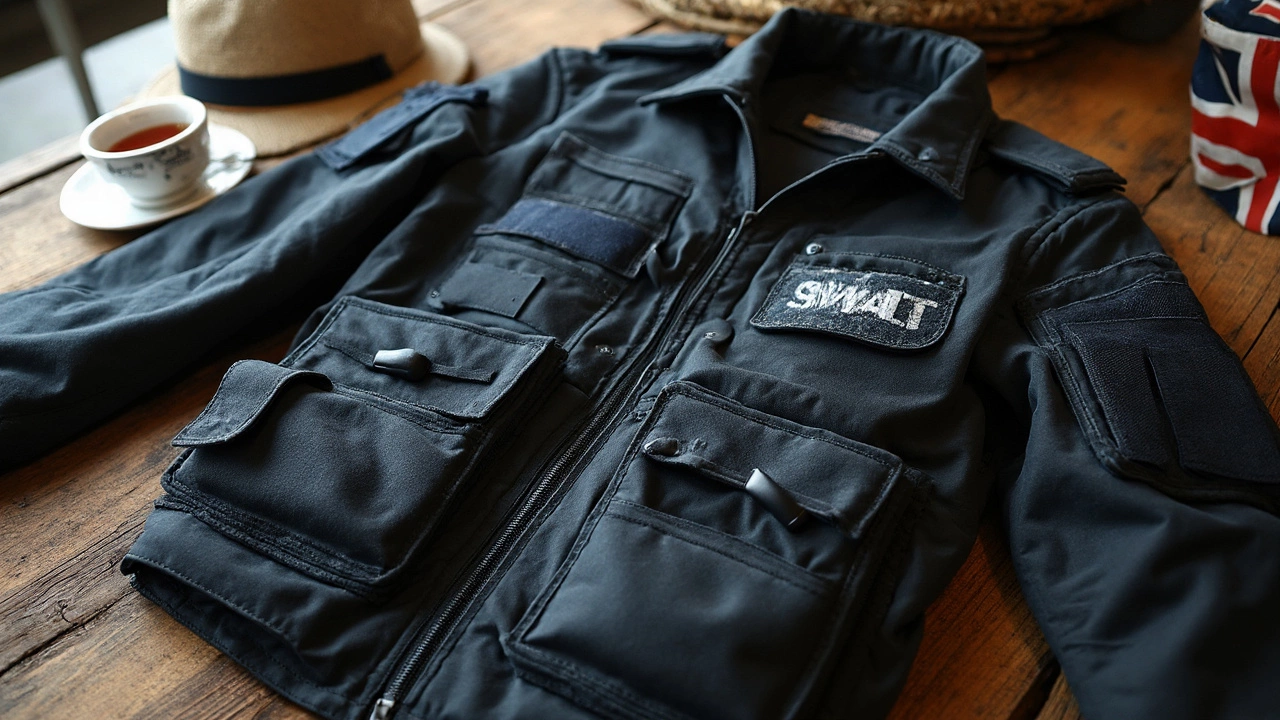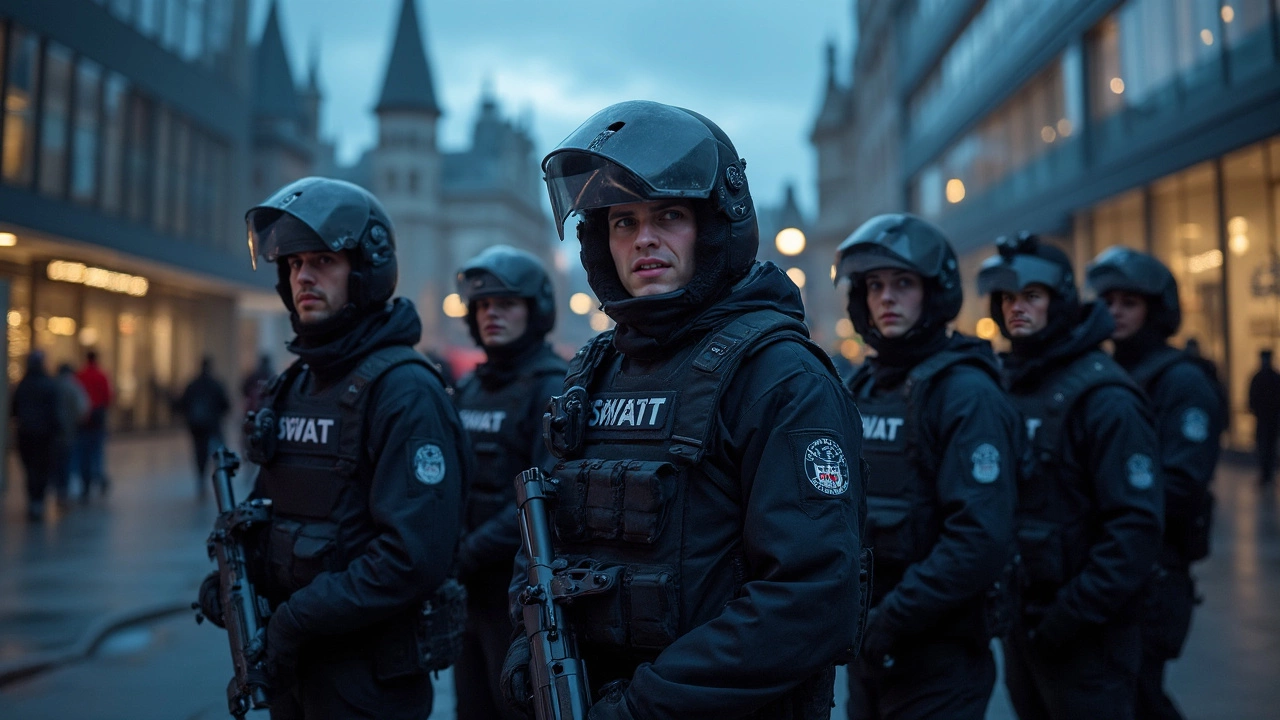Think of a SWAT jacket, and you're probably picturing those all-black, rugged jackets worn by elite police units on TV. But there's more going on than just the intimidating look. SWAT jackets are designed for real-world dangers, offering a mix of protection, mobility, and utility you can’t get from your regular windbreaker.
At their core, these jackets keep officers safer in extreme situations. This isn’t just about bullets—though, yes, some come with armor or padding. They resist tears, shed rain, and have enough pockets to stash gear you never even knew existed. Even if you’re not planning to join a tactical squad, knowing what makes these jackets different can help you pick out practical features for hiking, airsoft matches, or just feeling ready for anything life throws at you.
- The Basics of a SWAT Jacket
- Key Features and Materials
- How SWAT Jackets Are Used
- Tips for Civilians and Enthusiasts
The Basics of a SWAT Jacket
If you've ever wondered what makes a SWAT jacket any different from a normal coat, you're definitely not alone. The main thing to know: these jackets are built for specialized police work. "SWAT" stands for Special Weapons and Tactics, so the gear has to keep up with all kinds of risky operations—from busting down doors to search-and-rescue missions. A swat jacket isn't just about looking tactical; it's vital for safety and agility.
What actually counts as a SWAT jacket? First, it’s not the same as a regular police uniform. These jackets are designed with tough materials like nylon or polyester blends and sometimes have extra layers for added protection. Think of it like an upgrade—the SWAT jacket is specifically made to handle rougher situations, from bad weather to physical confrontations.
Here are a few key things that every real SWAT jacket covers:
- Protective Outer Shell: Resists rain, wind, and minor abrasions.
- Pockets Galore: Multiple roomy pockets for carrying radios, gear, and tools.
- Hidden Openings: Some have slots for inserting body armor panels or patches.
- Quick Fastenings: Easy zippers and Velcro closures for fast gear changes.
- Mobility: Cut and stitched so you can move freely—no bunching or restricting your arms.
Even if every department picks their own style, there are industry standards. For instance, most SWAT jackets are black, navy, or dark green for blending in during low-light operations. They’ll usually have patches or spots for "POLICE" or "SWAT" labels for quick ID—important during the chaos of an operation.
SWAT teams first started using tactical jackets regularly in the 1970s. By the 2000s, gear had improved so much that lightweight, high-protection jackets became standard. Here’s a quick breakdown of basic SWAT jacket features over the years:
| Decade | Material | Key Feature |
|---|---|---|
| 1970s | Cotton blends | Basic protection, bulky fit |
| 1990s | Nylon/polyester | Water-resistant, more pockets |
| 2000s | Ripstop fabrics | Lighter weight, armor inserts |
| 2020s | Advanced synthetics | Breathable, modular, tear-resistant |
That’s a quick run-through of the basics. The real takeaway? These jackets are all about utility, protection, and handling whatever the job—or the weather—throws at you.
Key Features and Materials
The real reason a swat jacket stands out? It’s built with a purpose. Let’s dig into what’s actually different in a SWAT jacket compared to any old raincoat or hoodie.
First off, these jackets need to survive rough treatment. Many top jackets use heavy-duty nylon or polyester shells. You’ll also find ripstop fabrics that keep small tears from spreading. For officers dodging flying glass, crawling on rough ground, or squeezing into tight spots, this kind of toughness makes a big difference.
Weather protection comes standard. Most SWAT jackets are windproof and water-resistant, and higher-end models use DWR (durable water repellent) coatings. That keeps the rain and grit out without turning the inside into a sauna. Plenty of police agencies ask for breathable linings so sweat doesn’t build up on long shifts.
Storage is huge. Forget just two pockets—look for chest pouches, sleeve pockets, and even secret compartments. Why? Officers pack radios, medical tools, ammo, and zip-ties. The jackets are literally designed to keep everything right at your fingertips.
Special features aren’t just about comfort. For example, Velcro patches make it easy to switch out name tags and insignia. Some tactical jackets have reinforced elbows and shoulders to help with weapon handling or hauling gear. You’ll also spot jackets with built-in slots to feed communication wires under the fabric.
And about actual protection: not all SWAT jackets are bulletproof, but many have pouches for armor plates or extra padding. This makes them super customizable, depending on what the job needs.
Here’s a quick comparison of common SWAT jacket fabrics and what they offer:
| Material | Main Benefits | Typical Use |
|---|---|---|
| Ripstop Nylon | Tear-resistant, lightweight | Outer shell, sleeves |
| Polyester | Weather-resistant, cheaper than nylon | Shell, inner lining |
| Soft-shell Fleece | Comfort, insulation | Cold-weather jackets |
| Kevlar Inserts | Cut and impact resistance | Reinforcement zones |
Last thing—don’t forget zippers and snap fasteners. SWAT jackets use extra-tough, snag-free zippers that won’t fail in a rush. Details like this sound small, but they can actually save precious seconds in critical moments.

How SWAT Jackets Are Used
SWAT jackets aren’t just about looking tough—they’re a key piece of gear for officers dealing with high-risk calls like hostage situations, raids, and barricade incidents. The whole point is to keep officers safe while giving them what they need to move fast and carry lots of tools. Let’s get into how these jackets actually show up in real action.
Most SWAT jackets go through real-world testing before they ever see duty. Teams check if the jacket holds up against doors, broken glass, dog bites, and unpredictable weather. The difference between a regular jacket and a SWAT version shows up during these intense moments—extra reinforcements, adjustable fits, and hook-and-loop patches for quick access are all made for split-second decisions.
- Protection: Some models come with Kevlar lining or let you add armor panels. While not every SWAT jacket is bulletproof, many block cuts, scrapes, and even some blunt force hits.
- Identification: Velcro patches display "POLICE" or unit names so other officers—and cameras—know who’s who, even in chaos.
- Pockets Everywhere: Extra magazine pouches, utility pockets, and hidden slots help carry radios, handcuffs, lights, and first-aid gear without needing a bulky backpack.
- Weather Resistance: Officers could be outside all night. These jackets often shed rain, wind, and even fire to a point. There’s rarely a weather forecast for SWAT calls.
To show how much action these jackets see, here’s a quick snapshot from a few big-city SWAT departments:
| Department | Average SWAT Calls per Year | Jacket Features Required |
|---|---|---|
| Los Angeles | 400+ | Armor slots, flame resistance |
| Houston | 320 | Padded shoulders, high-visibility patches |
| Chicago | 250 | Weatherproofing, reinforced stitching |
The bottom line: for SWAT teams, it’s function over fashion every time. Jackets aren’t picked because they look cool on TV—they’re battle-tested, picked apart, and rebuilt to handle danger on any given day.
Tips for Civilians and Enthusiasts
If you’re not part of law enforcement but find yourself drawn to the style or function of a swat jacket, you’re in good company. Loads of hikers, security workers, airsoft players, and people just wanting a tough everyday jacket are buying them. Here’s what you need to know before dropping cash on a tactical jacket for personal use.
- Fit matters: Don’t settle for a baggy or restrictive fit. SWAT jackets are built for movement, but they come in all shapes. Try one on, or double-check the sizing chart—especially under the arms and around the shoulders if you plan to layer up.
- Pockets and features: The pockets are a big deal. Check if you actually need a ton of them, or if you just want space for your phone, wallet, or keys. Some jackets have pockets designed for radio gear or armor inserts you’ll never use, which could add bulk for no reason.
- Weather resistance: Look for water-resistant layers, especially if you’re hiking or biking. Many civilian SWAT-style jackets skip bulletproofing but still use tough nylon or polyester fabric that shrugs off rain and light wind.
- Weight and ventilation: Some tactical jackets are heavy-duty because they’re meant to take a beating, but you might regret a heavy coat if you’re just running errands or walking the dog. Vent zippers and mesh linings help with airflow, which is a lifesaver outside of winter.
- Look and legality: Dressing like a SWAT officer is fine if you’re casual about it, but don’t try to pass as real law enforcement. Some cities and states have laws about “impersonating a police officer,” especially if there are patches or badges on the jacket.
If you’re on the fence about which features or brands to consider, check out this quick breakdown of popular civilian uses and what matters most:
| Hobby/Use | Key Features to Look For | Recommended Material |
|---|---|---|
| Airsoft/Paintball | Lighter weight, easy-access pockets, good ventilation | Polyester/Nylon blend |
| Outdoor Adventures | Weather resistance, reinforced elbows, adjustable cuffs/hoods | Ripstop nylon or softshell |
| Everyday/Urban Wear | Low-profile style, enough pockets, comfort fit | Polyester or lightweight canvas |
| Security Work | Badge holders, radio loops, sturdy build | Heavy-duty nylon or mixed synthetics |
Watch out for counterfeits or cheap knock-offs—some retail websites are flooded with jackets that look the part but fall apart after one wash. Stick with brands that get solid reviews from people actually using them in rough conditions. And remember, just because it looks tactical doesn’t mean you lose all comfort. A good jacket will hold up on a trail, in the city, or hauling gear at a weekend event without making you look or feel like a stormtrooper.
